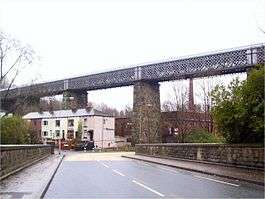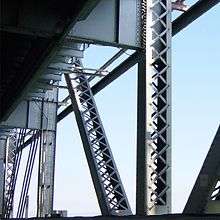Lattice girder


A lattice girder is a truss girder where the flanges are connected by a lattice web.[1]
Overview
The lattice girder type of design has been supplanted in modern construction with welded or bolted plate girders, which use more material but have lower fabrication and maintenance costs. The lattice girder was used prior to the development of larger rolled steel plates.
The term is also sometimes used to refer to a structural member commonly made using a combination of structural sections connected with diagonal lacing. This member is more correctly referred to as a laced strut[2] or laced tie, as it normally resists axial compression (strut) or axial tension (tie); the lattice girder, like any girder, primarily resists bending.
The component sections may typically include metal beams, channel and angle sections, with the lacing elements either metal plate strips, or angle sections. The lacing elements are typically attached using either hot rivets or threaded locator bolts. As with lattice girders, laced struts and ties have generally been supplanted by hollow box sections, which are more economic with modern technology. In some case seismic retrofit modifications replace riveted lacing with plates bolted in place.
Some structures employing lattice girders
- Manhattan Bridge.
- Runcorn Railway Bridge.
- Kew Railway Bridge.
- Dowery Dell Viaduct, demolished 1964.
- Bennerley Viaduct.
- Cayey Bridge, built 1891, in Puerto Rico
Some structures employing laced struts or ties
- The Eiffel Tower.
- The obsolescent eastern span of the San Francisco–Oakland Bay Bridge. The western span has been retrofitted with bolted plates replacing the lacing for added strength.The eastern span has been replaced.
- The internal structure of the Statue of Liberty.
- The sides of the Cape Fear Memorial Bridge.
See also
- Hares Hill Road Bridge
- Lattice truss bridge – an extension of the concept to form a deep truss
References
- ↑ "Definition of lattice girder". Merriam-Webster. Retrieved 2006-12-13.
- ↑ "Glossary of bridge terminology". University of Iowa Lichtenberger Engineering Library. Retrieved 2006-12-13.